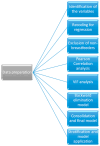Factors Influence Breastfeeding Duration after High Risk and Low Risk Pregnancies
- PMID: 39337237
- PMCID: PMC11431350
- DOI: 10.3390/healthcare12181896
Factors Influence Breastfeeding Duration after High Risk and Low Risk Pregnancies
Abstract
Background: Breastfeeding provides vital nutrients and fosters maternal-infant bonding, benefiting both mother and child. However, breastfeeding duration is influenced by various factors, especially in women of high-risk pregnancy. This study aims to identify predictors of breastfeeding duration among women of high-risk and low-risk pregnancy, focusing on exclusive and mixed feeding practices.
Methods: Conducted at a public hospital in Attica, Greece, this 20-month prospective cohort study (May 2020-January 2022) included 380 pregnant women, divided into high-risk and low-risk groups. The final sample of 157 women, after excluding non-breastfeeding participants, was assessed across five phases from prenatal to six months postpartum using interviews, calls, and surveys. Multiple linear regression identified key predictors, with statistical methods applied.
Results: Results revealed birth weight as a consistent significant predictor of breastfeeding duration. For women with high-risk pregnancy, additional factors like infant gender, jaundice, and early introduction of solid foods influenced breastfeeding duration. The mixed breastfeeding model for women with high-risk pregnancy explained 72.9% of the variance. Exclusive and mixed breastfeeding models for women with low-risk pregnancy also highlighted birth weight's influence.
Conclusion: The findings highlight the important role of birth weight and other specific factors in determining breastfeeding duration among women of high-risk and low-risk pregnancy. Further research is needed to validate these findings across diverse populations.
Keywords: birth weight; breastfeeding duration; exclusive breastfeeding; high-risk pregnancy; maternal health; mixed feeding; predictive factors.
Conflict of interest statement
The authors declare no conflicts of interest.
Figures
Similar articles
-
Breastfeeding Intention and Breastfeeding Postpartum Outcomes between High-Risk and Low-Risk Pregnant Women: A Greek Prospective Cohort Study.Int J Environ Res Public Health. 2024 Jun 9;21(6):755. doi: 10.3390/ijerph21060755. Int J Environ Res Public Health. 2024. PMID: 38929000 Free PMC article.
-
A prospective study of breastfeeding intentions of healthy weight and overweight women as predictors of breastfeeding outcomes.Midwifery. 2017 Oct;53:20-27. doi: 10.1016/j.midw.2017.07.002. Epub 2017 Jul 5. Midwifery. 2017. PMID: 28735032
-
The role of psychosocial factors in exclusive breastfeeding to six months postpartum.Midwifery. 2014 Jun;30(6):657-66. doi: 10.1016/j.midw.2013.07.008. Epub 2013 Aug 8. Midwifery. 2014. PMID: 23932036
-
Schedules for home visits in the early postpartum period.Cochrane Database Syst Rev. 2021 Jul 21;7(7):CD009326. doi: 10.1002/14651858.CD009326.pub4. Cochrane Database Syst Rev. 2021. PMID: 34286512 Free PMC article.
-
Interventions for supporting the initiation and continuation of breastfeeding among women who are overweight or obese.Cochrane Database Syst Rev. 2019 Sep 17;9(9):CD012099. doi: 10.1002/14651858.CD012099.pub2. Cochrane Database Syst Rev. 2019. PMID: 31529625 Free PMC article.
References
-
- WHO Guideline: Protecting, Promoting and Supporting Breastfeeding in Facilities Providing Maternity and Newborn Services. 2017. [(accessed on 25 April 2024)]. Available online: https://apps.who.int/iris/bitstream/handle/10665/259386/9789241550086-en.... - PubMed
LinkOut - more resources
Full Text Sources



